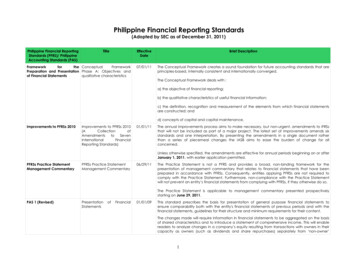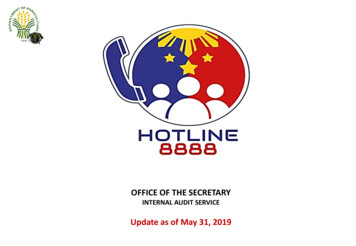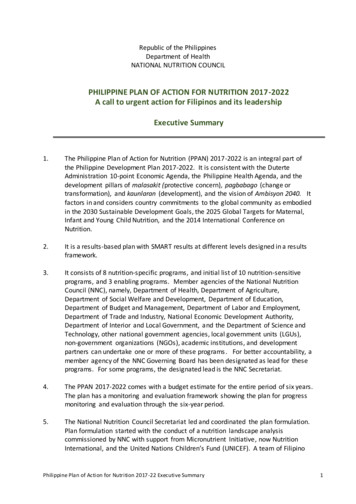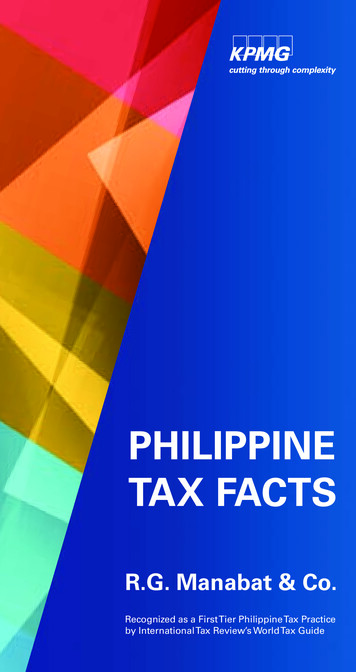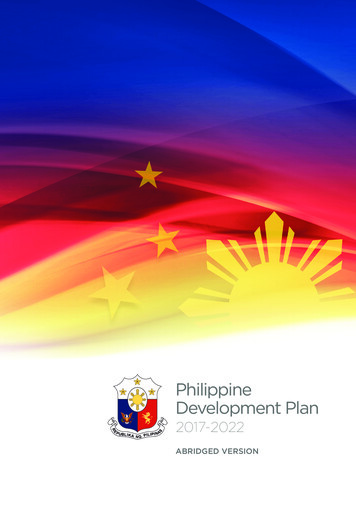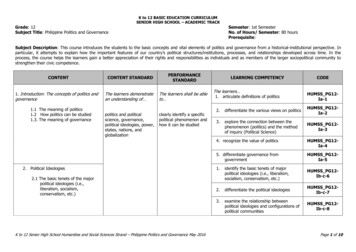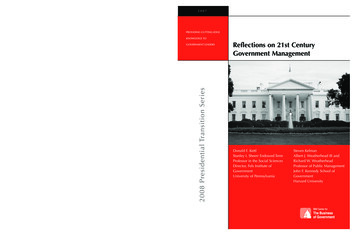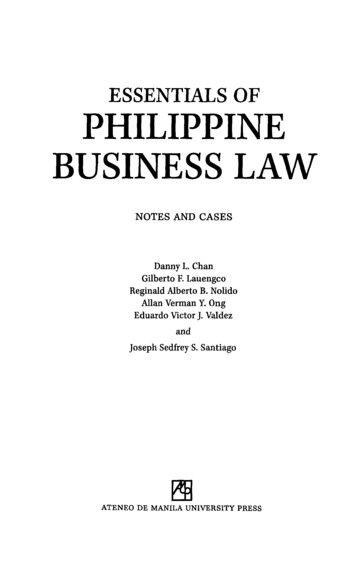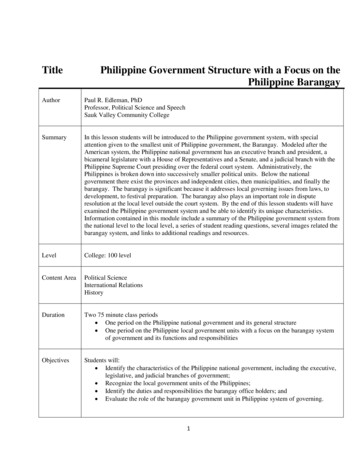
Transcription
TitlePhilippine Government Structure with a Focus on thePhilippine BarangayAuthorPaul R. Edleman, PhDProfessor, Political Science and SpeechSauk Valley Community CollegeSummaryIn this lesson students will be introduced to the Philippine government system, with specialattention given to the smallest unit of Philippine government, the Barangay. Modeled after theAmerican system, the Philippine national government has an executive branch and president, abicameral legislature with a House of Representatives and a Senate, and a judicial branch with thePhilippine Supreme Court presiding over the federal court system. Administratively, thePhilippines is broken down into successively smaller political units. Below the nationalgovernment there exist the provinces and independent cities, then municipalities, and finally thebarangay. The barangay is significant because it addresses local governing issues from laws, todevelopment, to festival preparation. The barangay also plays an important role in disputeresolution at the local level outside the court system. By the end of this lesson students will haveexamined the Philippine government system and be able to identify its unique characteristics.Information contained in this module include a summary of the Philippine government system fromthe national level to the local level, a series of student reading questions, several images related thebarangay system, and links to additional readings and resources.LevelCollege: 100 levelContent AreaPolitical ScienceInternational RelationsHistoryDurationTwo 75 minute class periods One period on the Philippine national government and its general structure One period on the Philippine local government units with a focus on the barangay systemof government and its functions and responsibilitiesObjectivesStudents will: Identify the characteristics of the Philippine national government, including the executive,legislative, and judicial branches of government; Recognize the local government units of the Philippines; Identify the duties and responsibilities the barangay office holders; and Evaluate the role of the barangay government unit in Philippine system of governing.1
ProceduresPrior to Day OneStudents should: Read – Pages 191 – 206 of: Dolan, Ronald E. (Ed.). (1991). Philippines: A country study.Washington, D.C.: GPO for the Library of Congress. The “About” section of the Philippine government’s website. Students should click oneach of the three branches and review the structure and duties of the executive, legislative,and judicial branches of the Philippine national government. Review – Appendix 5 – Image: The Philippine JudiciaryPrior to Day TwoStudents should: Read – Atienza’, Maria Ela L. (2006). Local government and devolution in the Philippines. InNoel M. Morada and Teresa S. Encarnacion Tadem (Eds.), Philippine politics andGovernance: An introduction (pp. 415-440). Diliman, Quezon City: Department ofPolitical Science, College of Social Sciences and Philosophy, University of the Philippines. Pages 1-17 of: Republic of the Philippines, Department of the Interior and LocalGovernment. (1991). Local government code of 1991, Book III, Local government units.Retrieved from http://www.dilg.gov.ph/PDF File/reports resources/DILG-Resources201162-99c00c33f8.pdf The 1987 Constitution of the Republic of the Philippines – Article X. (1987). Article X.Retrieved from le-x/ Review – Appendix 3 – The Structure of Local Governments in the Philippines Appendix 4 – Criteria for Local Government Unit Creation According to the 1991Local Government Code Appendix 6 – Image: Sample Barangay Assembly Organizational Chart, BarangayLinglinay Appendix 7 – Image: Sample Duties and Functions of a Barangay Secretary, BarangayLinglinay2
Appendix 8 – Image: Wall Poster, Barangay Linglinay Appendix 9 – Image: Assembly Meeting, Barangay GuihayDay OneProfessor: Lecture on the historical development of the Philippine national government and thecurrent structure and framework of the Philippine national government.Use questions 1-5 of the “Philippine Government Reading Questions” document to guidediscussion on the characteristics of the Philippine national government. Alternatively, havestudents discuss the reading questions in small groups and compare responses. Separategroups may also choose to examine individual branches of government and then report outto the full class. Students should consider the similarities and differences between thePhilippine national government and the US national government.Students: Students should have read and reviewed the preparatory readings and documents.Engage in discussion centered on questions 1-5 of the “Philippine Government ReadingQuestions” document.Day TwoProfessor: Lecture on the historical development of the local government units in the Philippines withan emphasis on the barangay unit of government and its structure, framework, duties, andresponsibilities.Use questions 6-9 of the “Philippine Government Reading Questions” document to guidediscussion on the characteristics of the Philippine local governments and the barangaysystem. Alternatively, have students discuss the reading questions in small groups andcompare responses. Separate groups may also choose to examine individual branches ofthe barangay system and then report out to the full class. Students should consider thesimilarities and differences between the Philippine barangay government system and theUS local government system. Students should further consider the effectiveness of thebarangay system.Students: Students should have read and reviewed the preparatory readings and documents.Engage in discussion centered on questions 6-9 of the “Philippine Government ReadingQuestions” document.3
Materials /ReferencesPhilippine Government Websites: Official Gazette of the Republic of the Philippines This is the official website of the Philippine government. The website contains the“Official Gazette,” which is the official record of the activities of the Philippinegovernment. The website also contains access to Philippine government documents,access to statistical data on the Philippines, and a description of the organization of thePhilippine government. The website also contains an “About” section that provides anoverview of the Philippine national government. Office of the President of the Philippines This is the official website of the Philippine President. The website provides access tothe activities of the President, Presidential initiatives, the history, structure, and makeupof the Philippine executive branch, and the various departments and agencies at thenational level. Republic of the Philippines House of Representatives This is the official website of the Philippines House of Representatives. The websiteallows access to Philippine legislation and provides information about the House ofRepresentatives, its structure, makeup, history, and about the individual members of theHouse of Representatives. Senate of the Philippines This is the official website of the Senate of the Philippines. The website allows accessto Philippine legislation and provides information about the Senate, its structure,makeup, history, and about the individual members of the Senate. Supreme Court of the Philippines This is the official website of the Supreme Court of the Philippines. The site containsaccess to Philippine Supreme Court decisions, information about the structure, makeup,and organization of the Philippine court system, and access to information on lowerPhilippine courts, such as the Court of Appeals and the Sandiganbayan Court.4
Resources: Atienza’, Maria Ela L. (2006). Local government and devolution in the Philippines. InNoel M. Morada and Teresa S. Encarnacion Tadem (Eds.), Philippine politics andGovernance: An introduction (pp. 415-440). Diliman, Quezon City: Department ofPolitical Science, College of Social Sciences and Philosophy, University of the Philippines. Atienza’ provides a brief historical overview of the development of local governmentunits within the Philippines from the pre-colonial era to the present. The authorhighlights the decentralized nature of local Philippine government units and how thisdecentralization has evolved over time. Atienza’ also addresses the current structure ofthe local government units and the consequences of both the structure anddecentralization of the units on the governing and development process within thePhilippines. Dolan, Ronald E. (Ed.). (1991). Philippines: A country study. Washington, D.C.: GPO forthe Library of Congress.o A web version is available at: http://countrystudies.us/philippines/o A PDF version is available ippinescount00dola 0/philippinescount00dola 0.pdf This book, produced by the Library of Congress, provides a broad introduction to allaspects of the Philippine nation, including history, politics, people, culture, geography,society, and religion. The government section of the text describes the constitutionalframework that has governed the Philippines since 1987, the national governmentalstructure, and the local government units and characteristics. Republic of the Philippines, Department of the Interior and Local Government. (1991).Local government code of 1991, Book III, Local government units. Retrieved fromhttp://www.dilg.gov.ph/PDF File/reports resources/DILG-Resources-20116299c00c33f8.pdf This is the Philippine law that defines and creates the structure of the Philippine localgovernment units. In particular, Title One – The Barangay, defines how the barangayunit of government is created, defines its specific roles, functions, and duties, andcreates and defines the various barangay elected offices and the barangay assembly andduties. Title Two – The Municipality, defines and creates the structure and duties of thePhilippine municipal unit of government.5
The 1987 Constitution of the Republic of the Philippines – Article X. (1987). Article X.Retrieved from le-x/ Appendices Article X of the 1987 Philippine Constitution creates the broad local government unitsof provinces, cities, municipalities, and barangays. It also provides the broad strokes ofthe powers and duties of the local units of governments. The detailed duties andfunctions of the local units are established through the 1991 law.Appendix 1 – Philippine Political StructureAppendix 2 – Philippine Government Reading QuestionsAppendix 3 – The Structure of Local Governments in the PhilippinesAppendix 4 – Criteria for Local Government Unit Creation According to the 1991 LocalGovernment CodeAppendix 5 – Image: The Philippine JudiciaryAppendix 6 – Image: Sample Barangay Assembly Organizational Chart, BarangayLinglinayAppendix 7 – Image: Sample Duties and Functions of a Barangay Secretary, BarangayLinglinayAppendix 8 – Image: Wall Poster, Barangay LinglinayAppendix 9 – Image: Assembly Meeting, Barangay Guihay6
Appendix 1 – Philippine Political StructureAppendix 1:PhilippinePoliticalStructureExecutive Branch:The current structure of the Philippine national government is the result of the 1986 People PowerRevolution that removed the longtime Philippine dictator, Ferdinand Marcos. The resulting 1987Constitution created a democratic republic modeled after the U.S. national system. The executivebranch is headed by the Philippine president, who is directly elected by the Philippine people andserves one six-year term in office. Philippine presidents cannot run for re-election.Legislative Branch:The Philippine legislative branch is comprised of two chambers, the House of Representatives andthe Senate. Members of the House of Representatives are elected either through the district methodor the party list method. Currently, the Philippines is divided into 234 legislative districts. Eachlegislative district elects one individual to represent the district in the House of Representatives.Thus, the Philippine House of Representatives has 234 members selected using the single memberdistrict (SMD) method. However, the 1987 Philippine Constitution also allows an additional 20percent of the House membership to be selected using the party list method. When Filipinos casttheir votes they cast two votes for the House of Representatives, one for a district representativeand one for a political party. Political parties receiving at least 2 percent of the national vote willearn a seat in the House. No political party can earn more than 3 seats through the party list votingprocess. The party list voting method is a form of proportional representation and is intended toprovide third parties and underrepresented groups representation in the legislature. There arecurrently 57 party list representatives. Each representative serves a three year term and can servenot more than three consecutive terms.The Philippine Senate consists of 24 members elected from at-large from the entire Philippines.Senators serve six-year terms and can serve no more than two consecutive terms.Judicial Branch:The Philippines has an independent judicial branch headed by the Philippine Supreme Court. TheSupreme Court is comprised of 15 justices. Supreme Court justices are appointed by the PhilippinePresident from a list of candidates prepared by the Philippine Judicial and Bar Council. TheJudicial and Bar Council is the body created by the 1987 Constitution to help ensure the selectionof qualified personnel for judicial positions. Below the Supreme Court is the Court of Appeals.The Court of Appeals is comprised of one presiding justice and 68 associate justices. Thesejustices are also appointed by the Philippine President upon recommendation by the Judicial andBar Council. Also just below the Supreme Court is the Sandiganbayan Court. The SandiganbayanCourt is the Philippine anti-graft and corruption court. Its purpose is to hold high rankinggovernment and military personnel accountable and to address the culture of corruption in thePhilippines. The Sandiganbayan Court consists of 15 justices appointed by the President uponrecommendation by the Judicial and Bar Council. Below these two courts are the regional andmunicipal courts. The Philippines also has a parallel system of Shari’a Courts for the nation’sMuslim population. Cases involving the Code of Muslim Personal Laws can be filed within the7
Shari’a Court. Shari’a Courts, however, are subject to oversight by the Court of Appeals and theSupreme Court. (See Appendix 5 – Image: The Philippine Judiciary)Philippine Local Government Units:While the Philippines is divided into 18 regions, these regions do not necessarily represent politicalor administrative units below the national government. Local government units are sub-dividedinto provinces or highly urbanized cities, such as the city of Manila, which is not a part of aprovince but its own separate political unit, and then further sub-divided into municipalities andbarangays. The barangay is the smallest administrative or local government unit in a province orindependent city. Like the American federal system, each local government unit is sovereign andhas its own rights, responsibilities, and duties, but each local unit is also subservient to therespective higher governmental authority. In the case of the Philippines, the barangay is undermunicipalities, which is under the province, which is under the federal government (See Appendix3 – The Structure of Local Governments in the Philippines). Each local government unit has theright to exist and its boundaries cannot be altered without a plebiscite by the political unit’spopulation. The 1987 Philippine Constitution limits local office holders to three year terms and notmore than three consecutive terms. Each local unit of government will participate in elections toselect the local government officials. Each local government unit has the right to generate revenueto be used exclusively by that respective political unit. Each highly urbanized city must have apopulation of at least 200,000 and each province a population of at least 250,000. Each barangaymust have at least 2,000 inhabitants. In large metropolitan areas, such as Manila, each barangaymust have at least 5,000 inhabitants (See Appendix 4 – Criteria for Local Government UnitCreation According to the 1991 Local Government Code).The Barangay Local Government Unit:Barangays, the smallest local government unit, developed in the Philippines well before theSpanish colonial era. The first barangay developed around groups of 30-100 households with mostlimited to kinship principles. While some barangay did organize into larger political units, such asthe Islamic Sultanates in Sulu, most remained small and decentralized. The arrival of Spanishcolonialism in the 1500s resulted in a more centralized governing system. The Spanish retained thebarangay, but created a hierarchy around municipalities, cities, and provinces. Thus, we see theoutline of the present local government units. Despite the creation of these different levels theSpanish retained ultimate authority over the various units. Control within the barangays wasfacilitated by a patron-client relationship between the Spanish and local barangay headmen andlocal chiefs. The Americans essential kept the Spanish bureaucratic structure in place with theirarrival in 1898. While some local government units had some autonomy to elect local officials, thelaws created by these local units were enforced at the national level. The Philippine Constitution of1935 created a strong unitary system of government with the president controlling localgovernment. The post-independence period after WWII witnessed a gradual decentralization ofpower and the slow return of authority to local governments. During the martial law period underFerdinand Marcos (1972-1986), however, this authority was used at the barangay level as a meansto extend martial law power down to the local levels (Atienza’, 2006).The current local government and barangay system in the Philippines is the result of the 1986People Power Revolution that removed Marcos from power and the subsequent 1987 Constitution.The new Constitution codified the existence of the local government units, including the barangaysystem, and granted each unit a level of autonomy. The move towards decentralization of power8
was in part a reaction to the centralization of authority under martial law, but the powers and dutiesof the local government units were further defined and further decentralized with the passage of the1991 Local Government Code as a means to draw support from local authorities. The 1991 lawwas revolutionary in that it ran counter to the tradition of centralization in most Southeast Asiannations (Atienza’, 2006). Atienza’ (2006) notes that this devolution was important in thePhilippines for five reasons:1) it gave local governments control over many of the basic social services, such as health andagriculture;2) it gave local governments enforcement power over many laws and regulations, includingenvironmental laws and food inspection;3) it gave local government the authority to tax and increased the share of funding from thenational government to the local barangay;4) it enhanced local civil society by allowing local political units the ability to create locallyelected governing assemblies, including at the barangay level, to govern over the localpopulation and the ability of the population to vote on local referendum; and5) it encourages local governments to form partnerships with the private sector to promotelocal development.Today, the barangay is the smallest unit of government in the Philippines. Each barangay is headedby a barangay captain and barangay assembly, each elected by the citizens of the barangay.Consisting of nine members, the barangay assembly is composed of seven council members plusthe barangay captain and the chairperson of the local barangay Youth Council.Barangays are responsible for governing and managing the population and territory within theirrespective borders. Like a city council in the United States, the barangay assembly and captainmeet in regular public forums to discuss and debate local issues and laws. Their activities caninclude allocating funding for roads and infrastructure projects, formalizing funding requests to thehigher municipal or province governments, creating the barangay budget, setting local curfews, toorganizing and sponsoring community and cultural activities.Barangays are also important because they offer Filipinos a system of alternative justice anddispute resolution to the formal Philippine court system. The Barangay Justice System, or theKatarungang Pambarangay, relies on the Philippine traditional community method of disputeresolution. The goal is to have the community elders and leadership mediate a mutually acceptableresolution between two disputing parties. A claimant can file a complaint with the barangay, whichis then addressed by the barangay captain. If the captain fails to resolve the dispute, mutuallyagreed upon third parties can be brought into the process. If the parties continue to fail in theresolution process, then the parties may choose to enter the court system. The advantage of thebarangay justice system is that it is intended to create a win-win solution and it can be quicker andless costly than the court system (Access, 2013).Below are the structures and duties of the various barangay political offices:9
Barangay Captain or Punong BarangayThe barangay caption is the barangay’s chief executive officer. Their duties may include thefollowing: Enforce laws;Sign contracts;Maintain public order;Preside over the barangay assembly;Coordinate the barangay development council;Approve the allocation of funds;Enforcement of environmental laws;Administer the operations of the local dispute resolution council or KatarungangPambarangay;Ensure the delivery of basic services; andPromote the general welfare of the barangay.Barangay Assembly or Sangguniang BarangayThe barangay assembly is composed of nine individuals, the barangay captain as the presidingofficer, seven members elected from at-large within the barangay, and the chairperson of the YouthCouncil or Sangguniang Kabataan (SK). The Youth Council represents youth in the barangaybetween the ages of 15-17. Assembly members must be at least 15 years of age. The barangayassembly is the local legislative body of government. The duties of the barangay assembly mayinclude the following: Make laws;Tax;Create the barangay budget;Build and maintain the barangay’s facilities and public works;Submit requests to higher political units of government;Economic development;Solicit and accept funds for barangay projects;Provide for the organization of community brigades;Control the proliferation of squatters;Prescribe fines for the violation of barangay ordinances;Organize community lectures on health, education, nutrition, etc.;Help create a local high school; andAssist the barangay captain in the performance of their duties.See also, Appendix 6 – Image: Sample Barangay Assembly Organizational Chart, BarangayLinglinayAppendix 8 – Image: Wall Poster, Barangay LinglinayAppendix 9 – Image: Assembly Meeting, Barangay GuihayBarangay Secretary10
The barangay secretary is nominated by the barangay captain and confirmed by a majority of thebarangay assembly. The secretary cannot be a member of the assembly, a government employee,or a relative of the barangay captain. The duties of the barangay secretary may include thefollowing: Keeping records and minutes of the barangay assembly;Make available a list of the assembly members and post this list publicly throughout thebarangay;Assist in the preparation of barangay elections and referendum votes;Assist the municipal civil registrar in the registration of births, deaths, and marriages;Keep a record of the barangay residents including name, address, gender, age, etc.;Submit the number of barangay residents to the assembly upon request; andExercise other duties as prescribed by law.See also, Appendix 7 – Image: Sample Duties and Functions of a Barangay Secretary, BarangayLinglinayBarangay TreasurerThe barangay treasurer is nominated by the barangay captain and confirmed by a majority of thebarangay assembly. The treasurer cannot be a member of the assembly, a government employee, ora relative of the barangay captain. The duties of the barangay treasurer may include the following: Keep records of Barangay funds and properties;Issue receipts for taxes and fees;Deposit monies in the barangay account;Disperse funds;Submit statements of income and expenditures;Produce a report of all barangay funds and property; andExercise other duties as prescribed by law.11
Appendix 2:PhilippineGovernmentReadingQuestionsAppendix 2 – Philippine Government Reading Questions1. What is the structure of the Philippine national government? What are the differentbranches of government at the national level?2. What are the characteristics of the Philippine executive branch?3. What are the characteristics of the Philippine legislative branch?4. What are the characteristics of the Philippine judicial branch?5. What are the differences between the branches of government in the Philippines and thebranches of the U.S. federal government?6. What are the different local government units within the Philippines?7. What are the responsibilities of the different barangay officials?8. How does the barangay differ from local government in the United States?9. Does the barangay unit of government appear to be an effective means of governing in thePhilippines?12
Appendix 3 – The Structure of Local Governments in the PhilippinesAppendix 3:The Structureof LocalGovernmentsin thePhilippinesSource:Atienza’, Maria Ela L. (2006). Local government and devolution in the Philippines. In Noel M.Morada and Teresa S. Encarnacion Tadem (Eds.), Philippine politics and Governance: Anintroduction (pp. 415-440). Diliman, Quezon City: Department of Political Science, College ofSocial Sciences and Philosophy, University of the Philippines, P. 430.13
Appendix 4:Criteria forLocalGovernmentUnit CreationAccording tothe 1991LocalGovernmentCodeAppendix 4 – Criteria for Local Government Unit Creation According to the 1991 LocalGovernment CodeCriteria for Local Government Unit Creation According to the 1991 Local Government CodeLocal Government UnitIncome (PhilippinePeso)BarangayMunicipalityCityHighly Urbanized CityProvincePopulationLand Area2,000 /5,000 for MetroManila and otherMetropolitan PoliticalSubdivisions)\P 2.5 MP 20 MP 50 MP 20 M25,000150,000200,000250,00050 sq. km.100 sq. km2,000 sq. kmSource:Atienza’, Maria Ela L. (2006). Local government and devolution in the Philippines. In Noel M.Morada and Teresa S. Encarnacion Tadem (Eds.), Philippine politics and Governance: Anintroduction (pp. 415-440). Diliman, Quezon City: Department of Political Science, College ofSocial Sciences and Philosophy, University of the Philippines, P. 430.14
Appendix 5 – Image: The Philippine JudiciaryAppendix 5:Image: ThePhilippineJudiciarySource:Government of the Philippines. (n.d.). Judiciary. Retrieved rt-July-021.jpg15
Appendix 6:Appendix 6 – Image: Sample Barangay Assembly Organizational Chart, Barangay l Chart,BarangayLinglinaySource: Paul R. Edleman16
Appendix 7:Appendix 7 – Image: Sample Duties and Functions of a Barangay Secretary, Barangay LinglinayImage:SampleDuties andFunctions ofa BarangaySecretary,BarangayLinglinaySource: Paul R. Edleman17
Source: Paul R. Edleman18
Source: Paul R. Edleman19
Source: Paul R. Edleman20
Appendix 8:Appendix 8 – Image: Wall Poster, Barangay LinglinayImage: WallPoster,BarangayLinglinaySource: Paul R. Edleman21
Appendix 9:Appendix 9 – Image: Assembly Meeting, Barangay GuihayImage:AssemblyMeeting,BarangayGuihaySource: Paul R. Edleman22
This book, produced by the Library of Congress, provides a broad introduction to all aspects of the Philippine nation, including history, politics, people, culture, geography, society, and religion. The government section of the text describes the constitutional framework that has governed the Philippines since 1987, the national governmental
